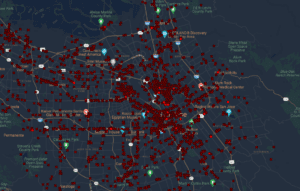Buyers all too often overlook the innate value of the land in which their potential new home sits. Some homes have unfixable property flaws that will guarantee the house will sell for less. Buyers are prone to buy a home with all the bells and whistles but miss the intrinsic value of the land in which it sits.
One steadfast mantra in the real estate game is location, location, location. People often underestimate the importance of location when buying or selling a home.
Meanwhile, location is one of the, if not, the driving factor that determines the value of your home.
You could have the most stunning walk-in closets, custom built-ins, a gourmet kitchen ( a few of my most desirable features in a home) but the landfill down the block. The landfill is the unfixable culprit that tanks your market value. This truth is often overlooked, as buyers are attracted to the features of a home and neglect the fact that they are buying a piece of property.
The land is the asset that generally continues to appreciate. Land appreciates because it is limited in supply. Suburban neighborhoods are confined to their marked out plots where those lying slightly outside of town have the potential to renovate and remodel without having to be chained by the existing footprint. Property is an asset that yields returns that are higher than the inflation rate. The land should be the number one consideration when purchasing a home.
However, the usual elements of location, location, location don’t dive deep into the actual piece of land. There are several available resources that buyer’s can take advantage of when determining the value of their property, that do not require a 3rd party. The three major considerations to take into account that will affect the value of your property are hazardous waste, water and noise pollution.
-
Hazardous Waste.
I am sure you read hazardous waste and assume that cannot possibly apply to me but you would be surprised. There are state run agencies and federal agencies that track the current hazardous waste zones. For example, the “Cleanups in my Community”
map provides a ton of data. You can google your address or potential purchase and discover what cleanups are underway, identify potential contaminated land as well as other key information like flood zones and sea level rise scenarios. You can get lost in a wormhole jumping from link to link discovering unbeknownst to you, your property is a block away from a “Red” zoned hazardous site.
Local municipalities in California now require new construction applicants to submit a statement that determines if their project will be near or on a property containing hazardous waste, toxic substances or underground fuel tanks. Envirostor allows you to search sites and facilities with links to project reports. When I learned of this, I instantly googled my address only to learn that I am merely blocks away from a contaminated clean up site. Who would’ve thought the dry cleaner down the block was a superfund site undergoing clean up?
-
Water.
Water is vital to all life. Water also is the most attacked, under-represented natural resource that continues to be depleted by pollution and climate change. The watershed below your property will affect how well your garden will grow and yet it is hardly ever a consideration to home buyers. Not only should your check the waterboards but you should check with local water authorities so you will be alerted to what will come out of the tap.
To give you an idea, here is a snippet from the above link of San Jose’s ground water contaminated sites.

-
Noise Pollution.
It is a catch 22, a desirable location implies connectivity. A key driver to deem a home in a good location is its connectivity. Accessible transportation, roads and even airports have long been the foundation of development. City sprawl is made possible by the network of transportation. Properties close to major highways fetch a better return. However, therein lies the rub. Too close and the value goes down. Noise pollution is real and having your backyard run to the edge of train tracks generally does not attract buyers. You can research the national transportation noise or for a more in depth analysis take advantage of Independent companies like “HOWLOUD” and their patented technology that generates ratings caused by vehicle, traffic and airplane noise. Real estate brokers and developers are utilizing their technology to attract clients to their properties by including noise statistics in their marketing material. In the end nothing is worse than being woken in the middle of the night by a train rattling through your bedroom. A consideration not to be overlooked.
In conclusion, when chanting location, location, location take the time to really dive deep into the land in which your potential home sits. You can fix a broken vanity but overhead power lines or an airport nearby, are bound to drive the value of your home down. Be proactive when looking to buy a property. Do your own research to the environmental health of your potential purchase. Remember, you can fix cosmetics, you cannot move a road.
